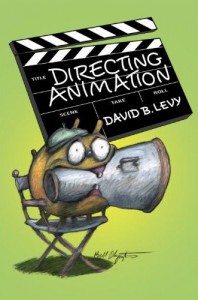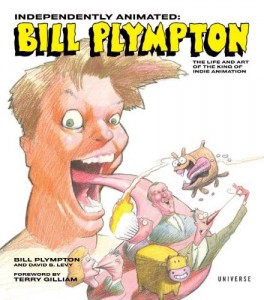Books &Independent Animation 02 Nov 2010 07:25 am
Just Published
The NYTimes features a longish article about Sylvain Chomet’s film, The Illusionist. It appeared in Sunday’s paper.
Likewise, the NYTimes also has an article about Megamind. It’s essentially a photo essay.
- George Griffin sent me a couple of links: one to an article at ArtForum Magazine about the scupture of animation artist Robert Breer; it’s a good read. Take a look here.
There’s also a spot called “Dot” from Aardman Animation that’s worth viewing at YouTube. Here It reveals what went in to making the world’s smallest character animated film and how it was shot using a Nokia N8.
Book Review
 - David Levy has fashioned an exceptional career for himself. He’s been producing animated shorts, teaching at the School of Visual Arts, and writing books. It’s the latter career choice that I’m interested in, today. Dave’s got a new book hitting the market today, and I’d like to talk about it.
- David Levy has fashioned an exceptional career for himself. He’s been producing animated shorts, teaching at the School of Visual Arts, and writing books. It’s the latter career choice that I’m interested in, today. Dave’s got a new book hitting the market today, and I’d like to talk about it.
Directing Animation is published by Allworth Press, and it’s his third book and a good companion to the other two: the first, Your Career in Animation: How to Survive and Thrive and the follow up, Animation Development: From Pitch to Production.
David is concerned with the nuts and bolts of animation. He wants to reveal how things work. In the first book, Your Career in Animation: How to Survive and Thrive, he focussed on how the individual should work in an animation studio. It was something that hadn’t been touched on before: proper manners and activities within a studio environment; essentially, how to work with others. The second book, Animation Development: From Pitch to Production spoke to those were trying to develop a series for television and how to present it to those in the position of power. It perfectly, again, taught the proper protocol for delivering your message and selling yourself. Neither of these books, really, had any predecessor.
This third book, Directing Animation, is also something original. It talks about the person who controls a film. There are many book on live-action directing, none that I know of – except this one – for animation. David spends much of his time talking to professionals and gives a guide to working within a group, a studio structure. He also spends plenty of space talking about the Independent animation Director.
I’m mentioned quite a bit in the book, as is Bill Plympton (who did the cover art for the book.) We’re the old timers, it would seem, and a lot of other younger directors such as David Palmer, Tatia Rosenthal and Ian Jones-Quartey get plenty of coverage. Even Web Directors, such as Xeth Feinberg, are discussed.
I’m sorry there isn’t time spent discussing the history of animation direction with some of the past geniuses who set the way: Chuck Jones, John Hubley, Bob Clampett, Jiri Trnka and the many others with strong personalities. It would be nice to see what made those people strong directors and how we can learn from their films.
The book gives more of an overview than an actual how-to approach to the subject. Unlike a book on how to direct a live-action film, there’s little talk of the language of film; no mention of such things as: “the inadvisability of cutting from LS to CU or back”, “the complications of shooting a pull back – zoom out” or even “crossing the 180°”. No, this book is more about getting the job and what’s expected of you. However, using a lot of anecdotes and answers to questions from the directors chosen, a lot is revealed. The subject takes us from TV series to animated features to web productions. A lot to cover, and it does it gracefully.
The book is a good companion to those questioning the career choice. However, it takes a lot of experience to do it properly. The knowledge of film structure and live action history has a lot to do with properly directing a film – even an animated film. Hitchcock once said that there’s only ONE possible setup for a scene, and you had to find that setup. In animation we usually jump from one hyper dynamic pose to another; it’s not film language but comic book language. A book can only tell you so much; the experience will reveal much more.
I’d say that if you want to direct, you should make a film – by yourself, if necessary. You’ll learn a lot of mistakes to avoid for the future and get your directing career going.
The book’s a great read, as are all of David’s works. I’m looking forward to his upcoming book about Bill Plympton. This is something different for David, and I’m curious to see how he’ll approach it.

_____________________

on 02 Nov 2010 at 8:16 am 1.Stephen Macquignon said …
Congratulations David on your new book I’m sure it is wonderful! It is funny even though we have only met a handful of times over the years I feel that we have known each other for a life time and wish you much success
on 02 Nov 2010 at 2:51 pm 2.Dave Levy said …
Thanks for the thoughtful review, Michael. Great observations. I love the idea about a chapter on the history of animation directing with a spotlight on those titans you mention.
I agree that the best way to learn directing for animation is to just do it, to make a film, and myself and lots of pros in the book give that exact advice.
As for a creative breakdown of directing, I tried to give as much info on that as possible but without making it a book on how to direct a specific script or sequence. I’m of the belief that one book can’t do everything, so I like a less is more approach. My least favorite animation books try to cover everything and end up giving everything the short thrift. So, my thought was, why not focus on the exact part of directing animation that nobody else has? Hence my approach to the subject. My book takes the point of view that one doesn’t direct animation, one directs people who animate. But, that would have been too wordy a title! : )
Thanks again for the great review! You gave me a lot to think about.
on 02 Nov 2010 at 3:39 pm 3.Eric Noble said …
Incredible news. I thoroughly enjoyed the article on The Illusionist. I may have to watch a few films from Jacques Tati before I go see this.
As for Dave Levy, I am interested in reading all three of his books. I want to get them for Christmas. I can’t wait to read the advice he has to give. Oh boy!!